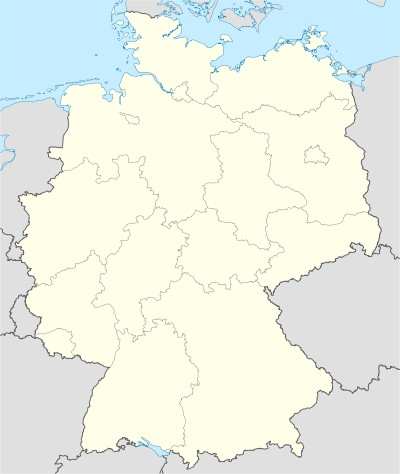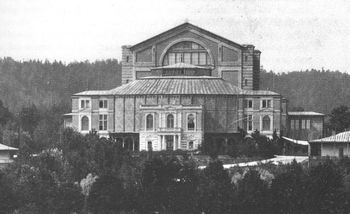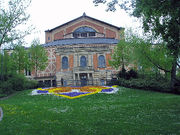Bayreuth
| Bayreuth | |
|
|
|
 |
|
 Bayreuth
|
|
| Coordinates | |
| Administration | |
| Country | Germany |
|---|---|
| State | Bavaria |
| Admin. region | Upper Franconia |
| District | Urban district |
| Lord Mayor | Michael Hohl (CSU) |
| Basic statistics | |
| Area | 66.92 km2 (25.84 sq mi) |
| Elevation | 340 m (1116 ft) |
| Population | 72,576 (31 December 2009)[1] |
| - Density | 1,085 /km2 (2,809 /sq mi) |
| Other information | |
| Time zone | CET/CEST (UTC+1/+2) |
| Licence plate | BT |
| Postal codes | 95401–95448 |
| Area codes | 0921, 09201, 09209 |
| Website | www.bayreuth.de |
Bayreuth (German pronunciation: [baɪˈʁɔʏt]; Upper Franconian: [ba(ː)ˈɾaɪ̯t]; English: /beɪˈruːθ/) is a city in northern Bavaria, Germany, on the Red Main river in a valley between the Frankish Alb and the Fichtelgebirge. It is the capital of Upper Franconia and has a population of 73,048 (2008).
Contents |
History

The city is believed to have been founded by the Counts of Andechs on an unknown date in the Middle Ages and was first mentioned in 1194. The city centre still possesses the typical structure of a Bavarian street market: the settlement is grouped around a road widening into a square; the Town Hall was located in the middle. The church stood apart from it and on a small hill stood the castle. Some sixty years later the town (at that time a tiny village) became subordinate to the Hohenzollern state, and when this state was divided, Bayreuth belonged to the county of Kulmbach. The city suffered several plagues and wars until in 1430 it was destroyed in the course of the Hussite Wars. In 1602 there was another plague, and fires damaged it in 1605 and 1621.
The turning point of the town's history was in 1603, when Margrave Christian of Kulmbach (Brandenburg-Kulmbach) decided to move his residence to Bayreuth. The development of the new capital stagnated due to the Thirty Years' War, but afterwards many famous baroque buildings were added to the town. Christian died in 1655. His grandson Christian Ernst, who ruled from 1661 until 1712, was an educated and well-travelled man, whose tutor had been the statesman Joachim Friedrich von Blumenthal. He had built the fountain of the margraves and an equestrian monument, placed at first in the courtyard of the Old Castle and now in the middle of the square in front of the New Castle. In 1701 the town of St. Georgen was founded, later absorbed into Bayreuth in 1811.
Bayreuth's Golden Age was during the reign of Margravine Wilhelmine, the favourite sister of King Frederick II of Prussia. Several parks and castles were built which constitute much of Bayreuth's present appearance, together with the Opera of the Margraves, the most beautiful extant baroque theatre in Europe.
In 1769 the last margrave of the Principality of Bayreuth died without an heir, and the state was annexed by the neighbouring Principality of Ansbach. Bayreuth was no longer a state capital. Soon after it became Prussian (1792), French (1806) and finally Bavarian (1810).
In 1804, the author Jean Paul Richter moved from Coburg to Bayreuth, where he lived until his death in 1825.
In 1872 the composer Richard Wagner moved to Bayreuth. For the connection between Wagner and the town, see below.
In 1886, the composer Franz Liszt died in Bayreuth while visiting his daughter Cosima Liszt, Wagner's widow. Both Liszt and Wagner are buried in Bayreuth; however Wagner did not die there. Rather he died in Venice in 1883, but his family had his body brought to Bayreuth for burial.
Later Bayreuth became a scene of the Nazi ideology. Nazi leaders often visited the Wagner festival and tried to turn Bayreuth into a Nazi model town. It was one of several cities in which town planning was administered directly from Berlin, due to Hitler's special interest in the town and in the festival. Hitler loved the music of Richard Wagner, and he became a close friend to Winifred Wagner after she took over the festival. Hitler frequently attended Wagner performances in the Bayreuth Festspielhaus.
During World War II, a subcamp of Flossenburg concentration camp was located here.[2] Bayreuth was heavily bombed at the end of World War II. One third of the city was destroyed and about a thousand people died.
After the war Bayreuth tried to part with its ill-fated past. The Bayreuth Festival started again in 1951. In 1975 the University of Bayreuth was founded and largely contributed to the further growth of the town. In 1999 the world gliding championship took place at Bayreuth municipal airport.


Richard Wagner and Bayreuth
The city is best known for its association with the composer Richard Wagner, who lived in Bayreuth from 1872 until his death in 1883. Wagner's villa, "Wahnfried", was constructed in Bayreuth under the sponsorship of King Ludwig II of Bavaria, and was converted after World War II into a Wagner Museum. To the north of Bayreuth is the Bayreuth Festspielhaus, an opera house specially constructed for and exclusively devoted to the performance of Wagner's operas. The premieres of the final two works of Wagner's Ring Cycle ("Siegfried" and "Götterdämmerung"); of the cycle as a whole; and of Parsifal took place here.
Every summer, Wagner's operas are performed at the Festspielhaus during the month-long Richard Wagner Festival, commonly known as the Bayreuth Festival. The Festival draws thousands of attendees each year, and has consistently been sold-out since its inauguration in 1876. Currently, waiting lists for tickets can stretch for 10 years or more.
Owing to Wagner's relationship with the then unknown philosopher Friedrich Nietzsche, the first Bayreuth festival is cited as a key turning point in Nietzsche's philosophical development. Though at first an enthusiastic champion of Wagner's music, Nietzsche ultimately became hostile, viewing the festival and its revellers as symptom of cultural decay and bourgeois decadence—an event which led him to turn his eye upon the moral values esteemed by society as a whole. Nietzsche's book Human, All-Too-Human developed out of this experience, a summary of which appears in his late book, Ecce Homo, and where many of these concerns are expounded in detail.
Main sights
- New Castle, seat of the margraves from 1753 on
- Bayreuth Festspielhaus
- Richard Wagner Museum (Villa Wahnfried)
- Jean-Paul Museum
- Franz Liszt Museum
- Margrave's Opera House, one of the finest Baroque theatres of Europe, built in the 18th century
- The German Masonic Museum
- The Goldener Anker hotel
- Baroque parks:
- park of Eremitage and Old Castle, former seat of the margraves, outside the inner town
- castle and park of Fantaisie, in the vicinity of Bayreuth
- park Sanspareil, about 30 km west of Bayreuth
- Ökologisch-Botanischer Garten der Universität Bayreuth, the university's botanical garden
City partnerships
Famous people
- Princess Wilhelmine of Bayreuth (1709–1758), monarch
- Johann David Schoepf (1752–1800), naturalist
- Johann Christian Ritter (1755-?), first printer in South Africa
- Jean Paul (1763–1825), writer
- Max Stirner (1806–1856), philosopher
- Richard Wagner (1813–1883), composer
- Oskar Panizza (1853–1921), psychiatrist, dissident author
- Fritz Rasp (1891–1976), actor
- Generalfeldmarschall Robert Ritter von Greim (1892–1945), soldier and aviator
- Florian Mayer (1983— ), professional tennis player
- Philipp Petzschner (1984— ), professional tennis player
- Maya Karin (1979— ), Malaysian actress, television personality, and singer
Economy
Transport
Bayreuth is served by Bindlacher Berg Airport.
References
- ↑ "Fortschreibung des Bevölkerungsstandes" (in German). Bayerisches Landesamt für Statistik und Datenverarbeitung. 31 December 2009. https://www.statistikdaten.bayern.de/genesis/online/online?sequenz=statistiken&selectionname=12411.
- ↑ Christine O'Keefe, [www.tartanplace.com/tartanhistory/concentrationcamps.html Concentration Camps]
External links
- Official website (German)
- University of Bayreuth website (German)
- Bayreuther Festspiele website
- Images from Bayreuth (English) (German)
|
||||||||
|
|||||||